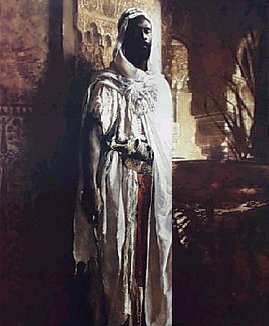This abruptly changed in 409 when Visigoths swarmed into Iberia from their German homeland.
The Visigoths were Arian Christians, meanng that, as followers of Arius (x-y), they denied the Doctrine of the Trinity, holding Jesus subservient to God.Visigoths were intolerant of all non-Arians (Christian or otherwise), so they slaughtered and plundered throughout Iberia for the next three centuries. A Roman witness of the early period said the land resembled an open air morgue.
Also, sciences and the arts were denounced and abolished.
So trade dwindled, as a "Dark Age" settled over the Iberian peninsula.
 Meanwhile, there developed the Islamics with greatest influence on European culture: The "Moors",
a people of Arabic and Berber extraction in Mauretania, a region of Western Africa below Morocco,
dominated by the Maur (Arabic-Berber). Moving to North Africa, on the Mediterranean, some leaders married into
Spanish or Visigoth famiies, or took fair-skinner Galician slaves as wives.
Meanwhile, there developed the Islamics with greatest influence on European culture: The "Moors",
a people of Arabic and Berber extraction in Mauretania, a region of Western Africa below Morocco,
dominated by the Maur (Arabic-Berber). Moving to North Africa, on the Mediterranean, some leaders married into
Spanish or Visigoth famiies, or took fair-skinner Galician slaves as wives. In 711 (79 years after Mohammed's death), the Muslim general, Tariq ibn Ziyad led forces from
Ceuta in Morocco to Gibraltar. (According to legend, this great "rock island is named for Tariq: "Jebel al Tariq" or "Taria's
mountina".)
The same year, Tariq led 12,000 men from Gibraltar to attack an army of 60,000 Visigoths at
Cádiz at the very bottom of Spain. By the Rio Barbate (south of Cádiz), in the
Battle of Barbate, King Roderic of the Visigoths was killed and his Christian army vanquished,
beginning seven centuries of Islamic occupation of much of Spain.
In 712, after a short siege, Tariq's forces captured the Visigoth capital, Toledo, which remained
a Moorish stronghold and border fortess for 400 years. Soon Moorish forces dominated the Iberian
Peninsula, giving it the Arabic name "Al Andaluz" (Andalucia). But their foray north was blocked
by a battle fought in France, between Toulouse and Poitiers, with forces led by the Frankish
king, Charles Martel.
Tariq achieved this because of his generous treatment of the vanquished contrasted so sharply
with the harsh rule of the Visigoths. For example, while approaching Toledo as the Visigoth
capital, Tariq sent word that those wishng to leave could safely do so, while those choosing
to stay could retain their property, freely practice their religion, and be governed by their own
rules and laws.
In 711 (79 years after Mohammed's death), the Muslim general, Tariq ibn Ziyad led forces from
Ceuta in Morocco to Gibraltar. (According to legend, this great "rock island is named for Tariq: "Jebel al Tariq" or "Taria's
mountina".)
The same year, Tariq led 12,000 men from Gibraltar to attack an army of 60,000 Visigoths at
Cádiz at the very bottom of Spain. By the Rio Barbate (south of Cádiz), in the
Battle of Barbate, King Roderic of the Visigoths was killed and his Christian army vanquished,
beginning seven centuries of Islamic occupation of much of Spain.
In 712, after a short siege, Tariq's forces captured the Visigoth capital, Toledo, which remained
a Moorish stronghold and border fortess for 400 years. Soon Moorish forces dominated the Iberian
Peninsula, giving it the Arabic name "Al Andaluz" (Andalucia). But their foray north was blocked
by a battle fought in France, between Toulouse and Poitiers, with forces led by the Frankish
king, Charles Martel.
Tariq achieved this because of his generous treatment of the vanquished contrasted so sharply
with the harsh rule of the Visigoths. For example, while approaching Toledo as the Visigoth
capital, Tariq sent word that those wishng to leave could safely do so, while those choosing
to stay could retain their property, freely practice their religion, and be governed by their own
rules and laws.Thus, from the very beginning of Moorish occupany of Spanish lands, a tolerance and enlightenment pervaded which was unknown until modern times. (Excellent source: www.orthohelp.com/geneal/SEPH_who.com.)
 At the beginning of the 10th century, Abderraman III (912-961, eighth Omeya emir in Damascus)
embarked for Spain and occupied Cordoba, establishing a dynasty that lasted until 1031. Founder
of the Cordoba School of Medicine, Abderraman transformed Cordoba into the largest and most
modern city in Europe, continuing the tolerant and enlightened occupation of Spanish lands by
Moors.
At the beginning of the 10th century, Abderraman III (912-961, eighth Omeya emir in Damascus)
embarked for Spain and occupied Cordoba, establishing a dynasty that lasted until 1031. Founder
of the Cordoba School of Medicine, Abderraman transformed Cordoba into the largest and most
modern city in Europe, continuing the tolerant and enlightened occupation of Spanish lands by
Moors.In 1170, the Muwahadis transferred their capital from Africa to Seville in Spain.
For correlative reading, please see The Rise and Fall of Paradise, When Arabs and Jews Built a Kingdom in Spain, Elmer Bendiner, Dorset Press, New York, 1993.